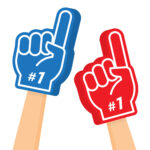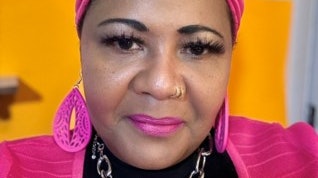In this era of anti-EDI attitudes and legislation, including book banning, I cannot help but push back and defend the importance of multicultural literature for all children. Those who are ill-informed about the purpose and benefits of multicultural literature must be challenged and enlightened; misinformation and disinformation must be corrected. Lists of high-quality characteristics have existed for decades. Two examples include: (1) Ten Quick Ways to Analyze Children’s Books for Racism and Sexism by The Council on Interracial Books for Children and (2) How to Tell the Difference by Slapin and Searle. A summary from Lee and Low Books is presented with additional features, examples, and repeating questions.
 Dr. Donna Y. Ford
Dr. Donna Y. Ford
● I recall visiting a school years ago, around 2012. The library contained books dated 1950-1970 about Africa, where the people were dressed in straw skirts, riding elephants, and living in huts. No cosmopolitan photos existed with buildings, cars, and contemporary clothing. What do Black children learn about themselves? What do other children learn from such outdated, stereotypical images? How did this affect their views of Black classmates and Black people overall?
Stereotypes. Beware of both creating and/or reinforcing stereotypes. Books should reflect individual people’s lives, rather than assigning general personality traits or behaviors to an entire group of people, with little to no exceptions. Several considerations are in order: (a) consider the dangers of caricaturing members of a culture; (b) consider who holds powerful positions; (c) consider the types of roles people of color have (e.g., employment and labor; caregiving). Also essential is to make sure that illustrations convey the reality that members of racial and ethnic groups are not visually homogeneous — we look different from each other.
● In books and on intelligence tests, I have challenged authors about the three aforementioned issues/considerations. For example, books had (and still do) Blacks in subordinate roles such as mopping floors while a white figure stood/looked over them. I vividly recall dark figures eating watermelons and bananas. I refuse to share the myriad appalling stereotypes these images conjure up. They are too offensive. And they beg the ongoing questions: What do Black children learn about themselves? What do other children learn from such outdated, stereotypical images? How did this affect their views of Black classmates and Black people overall?
Setting. Books must place/situate Blacks and other minoritized groups in accurate settings. Again, beware of stereotypes — distortions, over-generalizations, and misrepresentations.
● I will never forget being appalled reading an ABC book for preschoolers less than 10 years ago. A is for apple. B is for ball. E is for Eskimo. The ‘Eskimo’ was fishing in ice with an igloo in the background. First, the name is outdated. Second, fishing is not the only industry. Third, igloos are not the only and contemporary habitat. What do Inuit and Aleut children learn about themselves? What do other children learn from such outdated, stereotypical images? How did this affect their views of Inuit classmates and Inuit people overall?
Language. When a book includes the language of a specific culture, the actual language must be included rather than nonsense words or an invented language that mimics the authentic one. Translations must be accurate. Language is a significant part of our identities. Thus, it is essential that books accurately capture the multitude of languages that exist in the world, with no language presented as superior or inferior to another. While foreign languages are considered languages, there is still unwarranted controversy about African American Language, which is a rule-governed form of communication like all languages.
● I am always troubled when Black characters are portrayed as being incapable of speaking mainstream English and when people are surprised when we speak mainstream English. PLEASE stop using ‘standard’ and ‘correct’ English as both terms imply that any other language is ‘substandard’ and ‘incorrect’ – is wrong and inferior. The best example of this is Alim et al.’s Articulate While Black: Barack Obama, Language, and Race in the U.S. “Using their analysis of Barack Obama as a point of departure, Alim and Smitherman reveal how major debates about language, race, and educational inequality erupt into moments of racial crisis in America.” The authors share several examples of white people being surprised that former President Obama is so ‘well-spoken’.
Epithets. Far too many books contain epithets insulting members of a particular race or ethnicity. The N-word may be the most prevalent, controversial, and offensive.
● One of the most controversial books when I was a P-12 student (1960s-1970s), when my son was a P-12 student (1980s-1990s), and now that I have a grandson in P-12 schools is Twain’s The Adventures of Huckleberry Finn. The damn stories I could share about how traumatized I, my son, and millions of other Black children have been by this book!! There is no place in children’s literature for epithets. Period. What do Black children learn about themselves? What do other children learn from such outdated, stereotypical images? How did this affect their views of Black classmates and Black people overall? What permission is given to others to call Black children/people the N-word? Frankly, books such as this need to be substantively interrogated with students if adopted.
Difficult Topics and Issues. In tackling difficult/challenging topics, authors should present the complexity of issues and offer multiple perspectives. If they do not, then teachers must.
● I have seen many teachers adopt Hoffman and Binch’s Amazing Grace. Grace is told by classmates that she cannot be Peter Pan in a play because she is a girl and she is Black. White female teachers will take, head on, the sexism, asserting that girls can do and be anything they want to be. However, noticeably absent is attention to racism. I talk about this often, using Dr. James Banks’ additive level of infusing multicultural content into the curriculum where teachers play it safe; will discuss one ism (sexism) but not another ism (racism). I always intervene. I bring up Grace’s race and show teachers how to teach this ism. Conversely, I have witnessed Black female teachers teaching about both forms of discrimination. To do otherwise is to ignore and discount a significant part of Black girls’ identities; both matter. It is not enough for girls overall to be empowered; Black girls must be so, too. I am absolutely elated to see their joy and pride. So many Black girls have said to me: “Dr. Ford, I am a Black girl who can be anything I want to be – just like Grace and you”! (#RepresentationMatters). Speaking of Black females, a recent study reports that a disproportionate percentage of banned books are by them.
In sharing the above examples and recommendations, I want readers to contemplate the foolishness of opponents of multicultural literature. When high-quality and mindful of the impact of the content, authors offer all children opportunities to be affirmed and understood, and to affirm and understand others. I want this for all 49.6 million students enrolled in public elementary and secondary schools:
● 22.1 million white;
● 14.4 million Hispanic;
● 7.4 million Black;
● 2.7 million Asian;
● 2.5 million two or more races;
● 449,000 American Indian/Alaska Native; and
● 182,000 Pacific Islander.
Dr. Donna Y. Ford is a Distinguished Professor of Education and Human Ecology in the Department of Educational Studies within the College of Education and Human Ecology at The Ohio State University.
#Merits #Multicultural #Literature #Spite #Book #Bans #AntiEDI #Attitudes #Legislation










